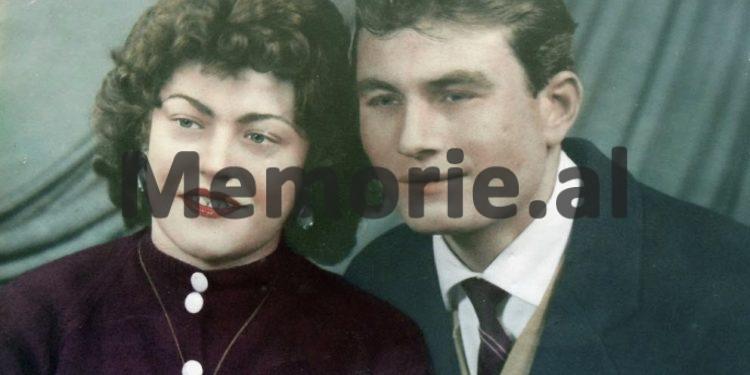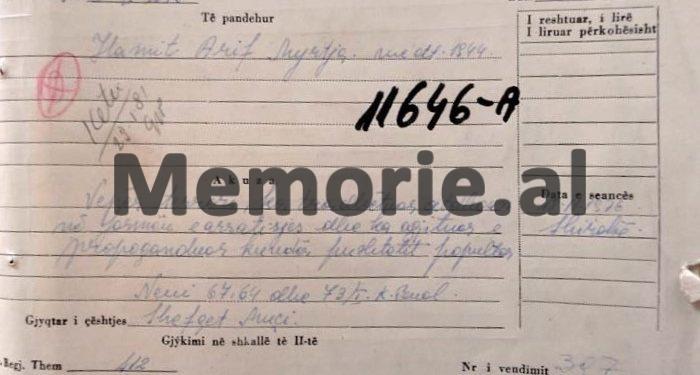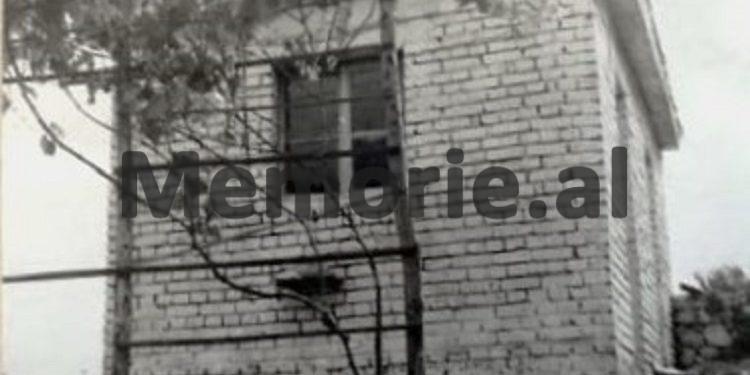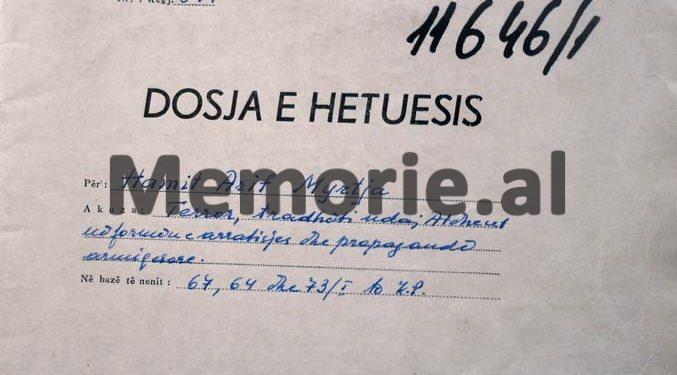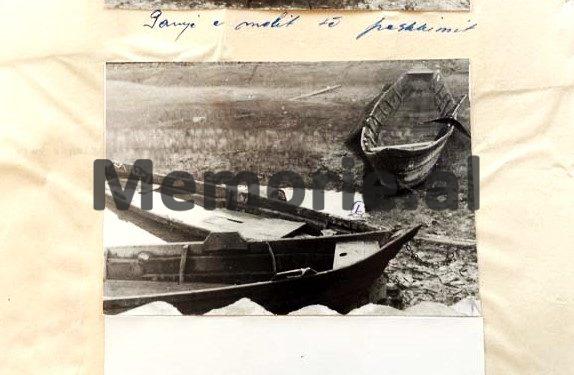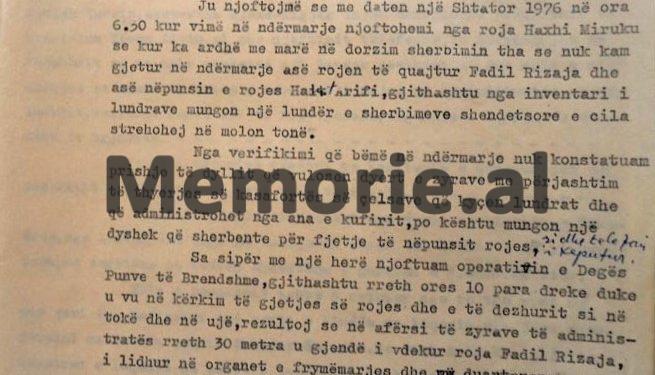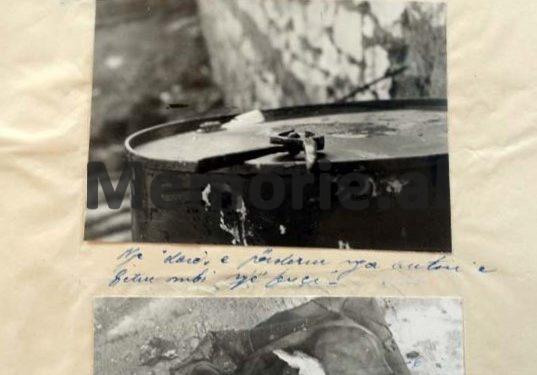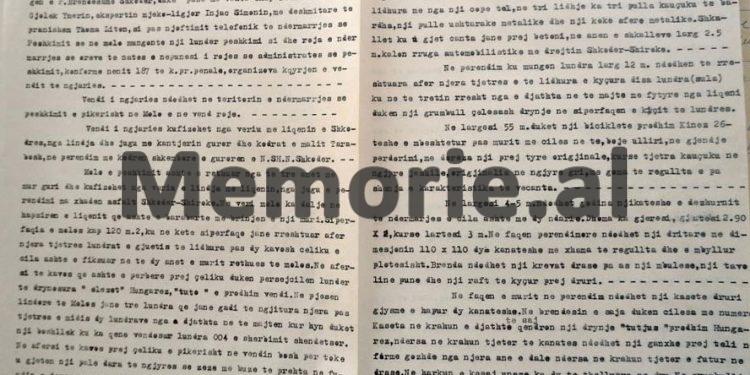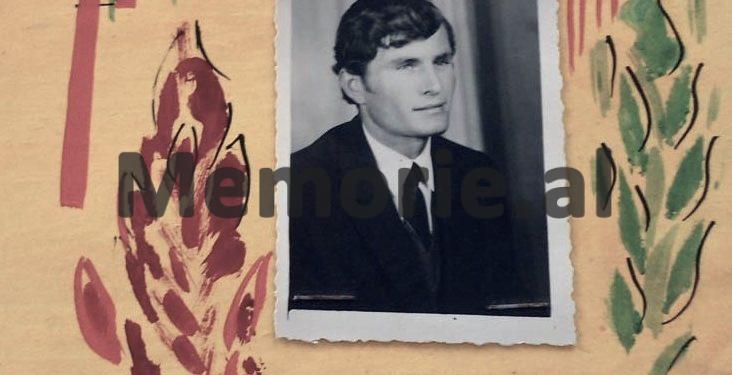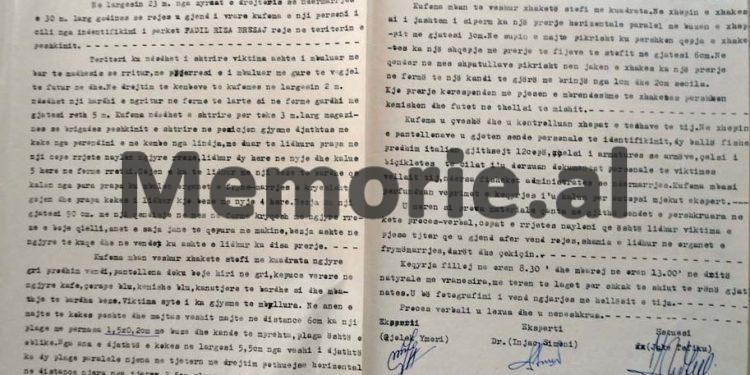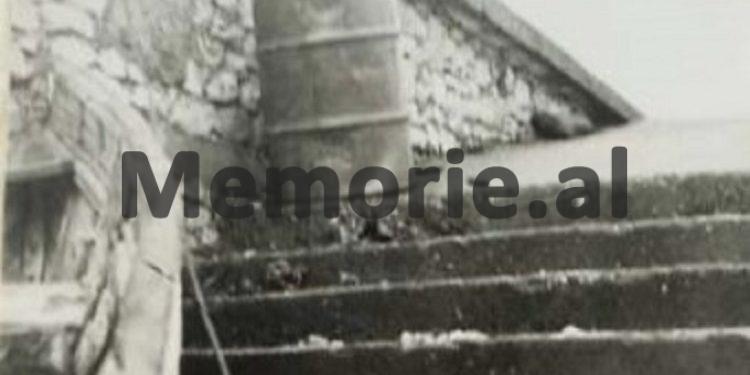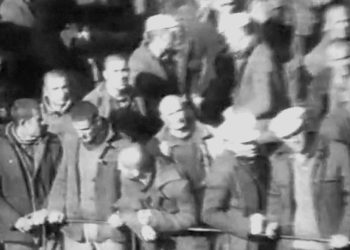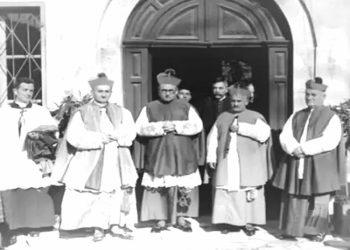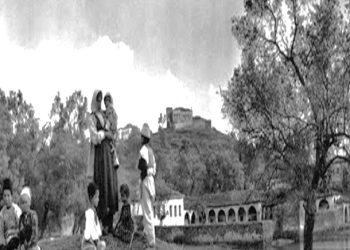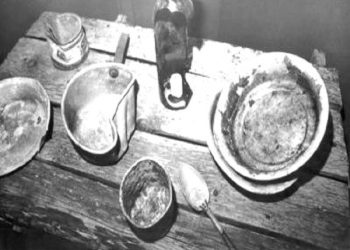By Dashnor Kaloçi
Part One
Memorie.al / It was the morning of September 1, 1976, when the workers of the Fishing Enterprise who arrived first at their workplace located on the shore of Lake Shkodra near the village of Shiroka, found that surprisingly the guard of the enterprise of that sector was missing, as well as the office staff, something that had never happened before?! This is because, among other things, there was also the pier where all the fishing boats were anchored, which, tied with chains and locked with a key, were considered objects of special importance and were under the control and double guard, both by the fishing enterprise and by the Border Post located in the village of Zogaj, where the state border with Montenegro, at that time part of the Federal Republic of Yugoslavia of Marshal Tito, was also located.
Although a torrential and stormy rain continued to fall, which had begun since midnight, the fishermen began to look for the guard and the foreman of their company, calling them by name, but in vain, because no one answered? But after a while, they were stunned and terrified, when just a few meters away from the fish warehouse, they saw a corpse lying on the ground with no signs of life…! It was the 60-year-old guard, Fadil Rizaj, who had been serving in that position for several years. No one dared to touch him with their hands, because not only was he bloody and with visible marks on his head and body, but his hands were tied with rope from behind his body and also his respiratory organs, tied with a cloth behind his head…! Which clearly meant that he had been killed…?
After that scene of horror, some of the fishermen ran to the offices to call the heads of their company and the Internal Affairs Branch as well, but the telephone line was cut and the connection to Shkodra could not be established…! Meanwhile, from other checks to find the company’s wreck, it was also found that one of the boats (fishing boats) was missing from the pier on the lake shore, precisely the one known as; “Health Boat”, and the safe that held their keys, was broken with a crowbar!
Meanwhile, the alarm was given and there were some of the officers and main chiefs of the Shkodra Internal Affairs Branch, who immediately determined that not only were they dealing with a serious crime, but also with an escape by boat across the lake, which, among other things, would also aggravate their position before their superiors at the Ministry of Internal Affairs in Tirana. Meanwhile, the news spread and the investigative group with the relevant experts immediately began work to uncover the crime that had occurred and unravel the entire event, which a few days later would shock not only the city and district of Shkodra, but also Tivar, Titograd and Ulcinj in Montenegro!
But what had really happened, who and why had killed the fishing guard Fadil Rizaja? How many people had escaped and what had happened at midnight on August 31, as September 1, 1976 dawned, as a heavy rain fell with thunder and lightning, which was said to have never been remembered, even by the oldest residents of those parts? Why were several dead bodies found on the shore of the lake on the Yugoslav side and another corpse on our side of the border, near the border post in the village of Zogaj? How was the main author of that escape able to swim to the part of the lake that belonged to the border of the Federal Republic of Yugoslavia, on that dark night with rain, waves and storm?
Who was Hamit Arif Myrto and what did he initially say to the residents of that area, when they saw him completely naked in the alleys of their village, as well as to the competent Yugoslav authorities, regarding the reasons for his escape? What did the UDB authorities ask Hamit during the investigation process in several separate offices in Tivar, Titograd and Ulcinj, where they sent him, frequently changing his location, his “cellmates” and the investigators who interrogated him? What did he testify to when they asked him about the military bases and units, the missile unit and other installations that were located at that time in the Shkodra district, as well as the tracts that were dropped in that city those days, against the Party of Labor and Enver Hoxha?
What did Hamit tell the UDB bodies, regarding his brother-in-law, a minister in the government headed by Mehmet Shehu, and also one of the closest people to the dictator Enver Hoxha, who remained in that position until the collapse of the communist regime? Who was the “photographer” from Shkodra who had escaped to Yugoslavia a few years ago and why were all the investigators asking Hamit about that person? Why did the Yugoslav UDB authorities decide to return Hamit Myrto to Albania, handing him over to the Albanian State Security bodies, even though they were convinced that he had not been sent on a secret mission?
What did Hamit testify during the investigative process, such as the reasons that had forced him to undertake that dangerous adventure, and also everything he had told the UDB? What did Hamit write in the letter addressed to Enver Hoxha to the Minister of Defense Beqir Balluku and how was it possible to find that letter in his house in Shkodra? What did Hamit’s family members, relatives, neighbors, work colleagues, the brigadier, the director of the Fishing Enterprise, the chairman of the People’s Council of the “Partizani” Neighborhood where he lived, and other people who were called to testify against him, testify during the investigation process, in the fall of 1976?
Why was the trial of Hamit Myrtos held in the village of Shiroka, how much was he convicted by the Shkodra District Court, the Criminal College of the Supreme Court and why did the Presidium of the People’s Assembly, leave their decisions in force, for his death sentence (by hanging) even after that terrible tragedy that had happened to him; where he lost his entire family? What were the last words that Hamit said before the firing squad and why, to this day, has his grave not yet been found?!
Regarding these and other events from that most serious and tragic that the Shkodra region experienced in those years and Montenegro as well, we are informed by the archival documents of the voluminous relevant file that Memorie.al has secured, which we are publishing in several issues (with the relevant facsimiles and photos), with the sole purpose of shedding light and making known the monstrous crimes that occurred at that time, where Albanians, in order to escape the communist hell, were forced to undertake the most dangerous adventures towards the state border, just like the main character of this event, Hamit Arif Myrtja!
INFORMATION FROM THE FISHING ENTERPRISE IN SHKODRA, SENT TO THE INTERNAL AFFAIRS BRANCH OF THAT DISTRICT, ON THE EVENT OF SEPTEMBER 1, 1976
PEOPLE’S REPUBLIC OF ALBANIA
Fishing Enterprise
No. 426 Prot. Shkodra on 1.9.1976
From the verification we made at the enterprise, we did not find any damage to the wax that seals the doors of the offices, with the exception of the breakage of the key safe that locks the boats, which is administered by the border, and a mattress that served as a sleeping place for the guard officer is missing, as well as the broken telephone.
As above, we immediately notified the Operative of the Internal Affairs Branch, also at around 10 am, searching for the guard and the missing person, both on land and in the water, resulting in the guard Fadil Rizaja being found dead near the administration offices, about 30 meters away, tied to the respiratory organs and with his hands behind his back.
Directory
Thoma Liti
MINUTE STATEMENT OF THE INSPECTION OF THE SCENE BY THE INVESTIGATOR OF THE SHKODRA INTERNAL BRANCH, JAKE TEFIKU, CRIMINAL EXPERT GJOLEK YMERI AND FORENSIC MEDICINE, DR. INJAC SIMONI
Injac Simonin, with witnesses present, Thoma Litin, according to the telephone notification of the Fishing Enterprise that a fishing boat was missing from the pier as well as the late-night guard of the enterprise, and the guard officer of the Fisheries Administration, in accordance with Article 187 of the Code of Criminal Procedure, organized an inspection of the scene. The scene of the incident is located on the territory of the Fishing Enterprise, precisely on the pier and at the guard post.
The site is bordered to the north by Lake Shkodra, to the east and south by the quarry and hills of Mount Tarabosh, to the west by the rocky hill and quarry of the Shkodra Municipality. The fishing pier is surrounded on three sides by a stone wall, and is bordered to the north-east by the lake, to the south and west by the asphalt road, Shkodra-Shiroka. In the north, the pier has an exit to the lake space that is equal to the edge of a wall. The surface of the pier covers 120 square meters, where on this surface the fishing boats are lined up close to each other, tied behind two steel cages, which are fixed on both sides of the surrounding wall of the pier.
Near the cage, which is made of steel, there are two Hungarian “Elzet” and “Tuto” boats of local production. In the eastern part of the Molo there are three boats, which are almost attached one after the other, and between the two boats, from right to left when entering, there is a gap where the boat 004 of the health service was placed. Near the steel cable, and precisely in the empty place for land, a pair of black tongs with sharp edges was found, at the end of the red handles.
At a distance of 25 m. near the place where the daggers were found, and precisely on the stairs leading up and down to Molo, a black inkel bag in new condition with two handles was found, the left arm sewn with a piece of dream and inside the bag were a pair of men’s blue velvet pants in used condition, partially soaked, in the jeans of the pants there was a green and black belt, an adjustable wrench, a pair of insulating pliers, several meters of twine, a quantity of copper wire tube, a sheet measuring 2.20 x 2 m., in its three corners it was connected by a button with two bronze metal rings, connected by a piece of wire, in three connections there were three white rubber buttons, a metal military button, and a metal business head.
The stairs where the bag was found are made of concrete, on the side of the stairs 2.5 m away, the Shkodër-Shiroka highway passes. To the west, where the boat is missing, 12 m away, there are several boats lined up close to each other, tied and locked, where in the third row, from right to left, facing the lake, a pile of keys, locks, can be seen on the surface of the boat’s keel.
At a distance of 55 m, a Chinese-made bicycle, 26 inches, can be seen leaning against the wall, with a lock on it, olive paint, in working condition, with handles, one of them original, while the other is green rubber, the original is gray, with regular tires and no special marks or characteristics. At a distance of 4-5 m, there is the one-story building of the company’s warehouse, which has two compartments. The room has a length and width of 2.90 x 2 m, and a height of 3 m. On the west side there is a window measuring 110 by 110 m., two-leaf with regular glass and completely closed. Inside there is a wooden bed without any cover, a work table and a locked wooden shelf.
On the west side of the wall, there is a half-open, two-leaf wooden box. Inside it are keys with numbers. On the right side of the box, there is a “Tutjus” lock, made in Hungary, while on the other side of the box; there is a wire hook in the shape of a nail, protruding on one side, while on the other side, inserted into the board. In the arch of this ring, there are two recesses in the wood. In the collection of locks that were found in the (Lundra) unnumbered sule, a lock with no. 004 and in the last hole of the opener, a card with the same number, hanging like an earring.
From further investigation of the scene, at a distance of 3 m. from the guardhouse, on the side of the flowered sidewalk, a pink nylon mesh membrane 1.80 m long is visible. In front of the door of the building where the guard stood in the flowerbed, there is a hammer with a short wooden handle, on the one hand pressing, and on the other hand sharp, with a slit in the middle. At a distance of 23 m. from the offices of the enterprise directorate and, 30 m. from the guardhouse, the body of a person was found murdered, who by identification belongs to FADIL RIZA BREZAJ, a guard in the territory of Peshkim.
The territory where the victim is lying is covered with tall grass, sloping and covered with small stones embedded in the ground. Towards the feet of the corpse, at a distance of 2 m., there is a vine raised in a high shape, like a fence, about 5 m long. The corpse is lying on the ground, about 3 m. away from the warehouse of the Fishing Brigade, lying in a half-right position, with the head to the west and the feet to the east, with his hands tied behind him with a piece of pink nylon net, tied twice with a knot and passed five times in a circle.
His mouth is tied with a white sash, from front to back, where it covers the respiratory organs and mainly the mouth and from behind the head this sash is tied with a knot four times. The sash is 90 cm long, with an embroidery in the middle in the form of crosses, in pink and sky blue, its sides are sewn by machine, the sash is red, and in the places where it is tied, there are several cuts. The corpse is wearing a locally made gray checked fabric jacket, gray denim pants, brown summer shoes, blue socks, a blue shirt, white boaters, and beige white underwear. The victim’s eyes are half closed. On the left side of the head, below and to the left of the left ear, at a distance of 6 cm., there is a wound measuring 1.5 x 0.2 cm., with sharp edges and corners, the wound is oblique.
On the right side of the head, at a distance of 5.5 cm. from the right ear, there are two wounds parallel to each other, with an almost horizontal direction at a distance of 2.5 cm from each other, the upper wound is 3 X 0.1 cm in size, and the second wound below, 1.5 X 0.1 cm., perpendicular to the second wound, there is another wound, with sharp edges and corners, 1.5 X 0.1 cm., further to the right there are two other wounds, the first horizontal with a length of 2 cm., the second below it 0.1 cm. knife. On the left side of the head there is a wound measuring 2 X 0.2 cm. On the back above right there is another wound with sharp edges and corners 2 X 0.1 cm. There are scratches and bruises on the forehead. The wounds on the head are deep to the bone and there is blood flow, under the right ear there is a small pool of blood.
The corpse is wearing a checked fabric jacket. In the outer, upper pocket of the jacket, there is a horizontal cut parallel to the edge of the pocket, with a length of 3 cm. On the left shoulder, exactly where the seam of the jacket passes, there is a tear with a cut in the fabric threads, with a length of 6 cm. In the center between the shoulders, just under the collar of the jacket, there is a cut in the form of an angle with ribs 1 cm wide and 2 cm. each. This cut corresponds to the inside of the jacket, passes through the shirt and goes deep into the flesh.
The corpse was undressed and the pockets of his clothes were checked. In the pocket of the trousers, personal belongings were found, two Italian-made cartridges, a total of 12 pieces, the key to the weapon’s armor, the bicycle key, and the victim’s personal documents, which were handed over to his brother, while the cartridges were handed over to the enterprise administration. The body, after the examination was completed, was handed over to the expert doctor for an autopsy. The bag with all the items described in this report, the pieces of the nylon net that the victim was tied to, the rest that was found near the guard post, the handkerchief tied to the respiratory organs, the pliers and the hammer was taken as material evidence.
The examination began at 8:30 and ended at 13:00, in natural light with clouds, with wet terrain due to the rain that fell during the night. The scene of the incident was photographed with its details.
The report was read and signed.
Expert Expert Investigator
Gjolek Ymeri Dr. Injac Simoni Jake Tefiku
The witness
Thoma Liti
COMMUNICATIONS OF THE MINISTRY OF INTERIOR, ON THE EVENT OF THE ESCAPE OF HAMIT ARIF MYRTJA AND THE FINDING OF THREE BODIES BY THE YUGOSLAV SIDE AND ONE OF THE ALBANIAN BORDER GUARDS IN THE VILLAGE OF ZOGAI ON LAKE SHKODRA
PEOPLE’S REPUBLIC OF ALBANIA SECRET
MINISTRY OF INTERNAL AFFAIRS Copy No. 1
GENERAL BRANCH Tirana 3.9.1976
OPERATIONAL COMMUNICATION No. 210
BORDER DIRECTORATE
The Shkodra Internal Affairs Branch announces that on 1.9.1976 in the morning, at the Shkodra Fishing Enterprise, near the building, the enterprise guard was found stabbed to death, and with his hands tied, while the guard’s employee was not found. Also, a boat was missing, the chain of which had been cut. The boat key box and the materials warehouse were found open. (The event was reported late by the Border Directorate).
PEOPLE’S REPUBLIC OF ALBANIA SECRET
MINISTRY OF INTERNAL AFFAIRS Copy No. 1
GENERAL BRANCH Tirana 5.9.1976
OPERATIONAL COMMUNICATION No. 211
SHKODRA
Regarding the announcement made in the operative communiqué No. 210 dated 3.9.1976, on the murder of the guard of the Fishing Enterprise, and the absence of a boat on 4.9.1976 at 15.00, the Yugoslav side submitted a letter to the P.K.K. Hot stating that on 1.9.1976, the Albanian citizen Hamit Myrtja, along with his wife Hasien and three children under the age of 8, had illegally crossed into Yugoslav territory. The wife and three children drowned after the boat capsized in bad weather. The wife and two sons, aged 3 and 5, were found and buried in the village of Cicllak in Yugoslavia, while Hamit is being pursued by the competent Yugoslav authorities. On 4.9.1976 at 17.30, the P.K. unit Zogaj, during a search of the lake shore, in the region of pyramid No. 9 C, found the body of an 8-year-old girl. Memorie.al




